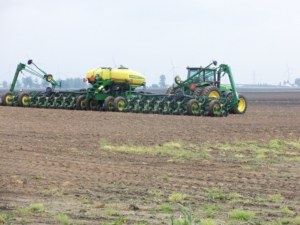
Many items say to store them in a ‘cool, dry place’….right now, our soils would appear to qualify for that ‘cool, dry’ place….
With the 2022 Planting season upon us, we wanted to give a quick update as we begin planting.
The 2022 planting season is coming with different challenges than the past few years, most especially the very dry conditions of this past winter and early spring. Below is a picture of precipitation ranks by climate districts for the period from Oct 31, 2021 to April 8, 2022 This is based on the past 130 years of data. 1 means the wettest out of 130 years and 130 means the driest out of the past 130 years. As you can see, NE Nebraska ranks at 129, so only one year was drier than 2022 during this time period. This means we are facing drier conditions at planting than we have seen in most of our lifetimes. This is not a reflection on soil moisture profiles, but it is an indication of what the top few inches of soil (ie. seedbed) will look like at planting.
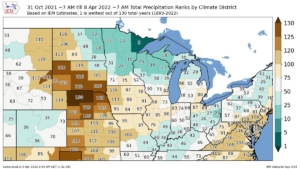
It has not only been dry, but we have also been on the cool side the past few weeks. However the new forecasts are potentially showing a nice planting window opening up next week into the last week of April. The next three photos show the current short-term forecasts for temperatures and precipitation:
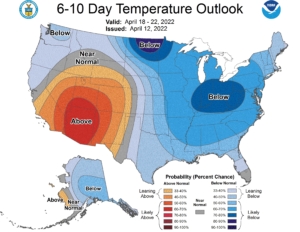
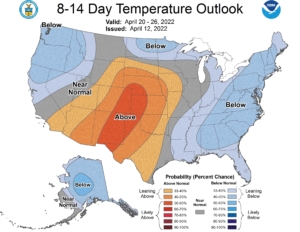
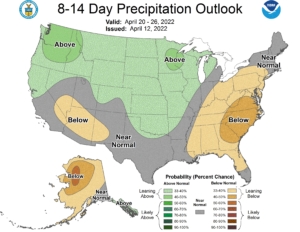
The first two photos are the 6-10 day and 8-14 day temperature outlooks issued on April 12 with valid dates from Apr 18-26. The last photo is the 8-14 day precip outlook. It is possible that after our current cold snap, we may see temps warm up early-to-mid next week and into the last week of April….even the precipitation map shows us in the above normal category….how about that!! Keep in mind that the first 48 hours after planting are critical for germination as the plant will imbibe the water needed for germination during that time frame regardless of soil temperature. This means planting into a few days of warmer weather will improve the chances for the seed to imbibe warmer water. Right now, we would expect early-to-mid next week to be a good time to begin planting, with weather conditions also conducive for irrigating as well. Before this current cold snap, soil temperatures were averaging in the mid-40’s….this will lower over the weekend to around 40 most likely. However, soil temperatures should warm up quickly if we get a stretch of warm weather.
The warmer temperatures would be most welcome, however, it still appears that we will be dealing with very dry conditions in the top 4-6 inches as we begin planting. This will influence our management practices as we go through the planting season. The good news is that, considering the past few months, our overall soil moisture profile is not that bad….in fact, I was surprised how much moisture is still available in the top 8 inches. However, the top 8 inches (and especially the 2-4 inch range) in most fields will be much shorter on available moisture at planting than the past number of years. Below are some bullet points to keep in mind as you begin and proceed with planting.
- Seed/Soil Contact: Good seed-to-soil contact this year will be key! In dry conditions, it gets more difficult to get good seed/soil contact as air pockets are increased. A perfect soil is 50% soil, 25% air and 25% water. We are not at a perfect soil, so the soil structure in the top foot is somewhat screwed up. As the water gets replaced by air, the soil particles shift and we get more air gaps. Though the total amount of air space increases, the air spaces themselves are smaller, which can influence moisture infiltration. In other words, under a heavy water application, one can see runoff in these dry conditions as the soil pore openings are reduced slowing water infiltration….there are a lot of pore openings, it’s just that they are very small openings. We have seen this a lot on sandy soils that are so dried out that water just ‘sheds’ off and never soaks in….even heavier soils can be so dried out that water infiltration is slower. The seed will be placed in conditions that are potentially more rocky and crumbly. It may be best to make the first irrigation pass at a lower rate (.30-.40 inch) to set the irrigation track and to get the soil in better shape to take a heavier amount….and then apply .75+ amounts.
- Even Emergence: Even emergence is always important, however, in dry conditions this gets more difficult to achieve, as some areas in the field will have adequate moisture to start germination while others will not….all of this is impacted by residue cover as well.
- Irrigation: With no rainfall, irrigation becomes the only tool to make sure moisture is adequate for uniform emergence. Making sure your pivot is ready to run will be as important this year as making sure your planter is ready. If no rainfall is occurring, the pivot needs to run as soon as the planter leaves the field, especially if temperatures warm up, which would then lead to a quick warm up of the soil. Also keep in mind that irrigation coverage is never as good as rainfall….if you have sprinkler packages that were causing problems last year, they will cause problems for emergence this spring if not fixed. Rye cover crop fields will also be drier as we move through the planting season.
- Tillage & Pre-watering: In some cases it may be necessary to pre-water, especially the light sand. Having some moisture in the sandier soils makes for a better seedbed and better seed/soil contact. It may be the best to make a pre-water .40-.50-inch pass before planting. This will improve infiltration and give you a better seedbed to plant in. Keep in mind tillage in the sand as well. Dry soils will fluff up more, so it may be best to till the soil 2-3 days ahead of the planter….then pre-water…this will allow the soil to ‘settle’ and ‘seal’ somewhat, and then come in and plant. It may not be best to till right ahead of the planter this year, especially in the sandy soils. Best also, to do as little tillage as possible on the dryland acre. Leave them untouched if you can. Conserving any moisture you can will pay dividends if the year stays dry.
- Crop residue: Due to the lack of moisture, last year’s crop residue has not broken down at all which will impact planting depth uniformity and crop emergence. The high winds we have experienced this winter has also impacted where the residue lays in the fields. Some areas in the field are bare while others are now 2-3 or more inches deep with crop residue. This will impact seed depth uniformity (which impacts emergence)….having row cleaners that can be variably controlled from the cab will pay this year….
- Pre-emerge Herbicide control: If the dry conditions persist over the next month, expect pre-emerge herbicide performance to be reduced. We get the best herbicide control in those years when we are getting .30+ inch every other day as the herbicide stays in solution. It is more difficult to keep the herbicide in soil solution under dry conditions. It will also take more moisture to incorporate the herbicide into soil solution in these conditions vs. other years.
- Crop injury from fertilizer burn: Potential for crop injury from fertilizer salt burn will be higher this year due to the dry conditions. In dry years, we usually see anhydrous burn as well as salt injury from fertilizers placed with the seed. Not saying this will occur, but the potential is there.
- Bottom line: If no help from rainfall, expect to water early and often for all of the above bullet points. In fact, one may need to slow planting down if that’s what it takes to make sure the pivots are running.
- Dryland: Not much one can do under these conditions for the dryland acre, however, it may be best to delay planting those dryland fields and wait for a potential rain.
Most Important Bottom Line: Keeping praying for rain….some rainfall would eliminate most of the above bullet points! Also, stay safe and be flexible. We’ve been here before and we got the crop planted…and up…and grew good yields….we will do the same again!
Please call us with any questions or concerns you may have as you begin planting. We are ready to help you get the crop in and up in the best shape we can! Thanks for you support!!!
Starman Seed Service, Inc.

